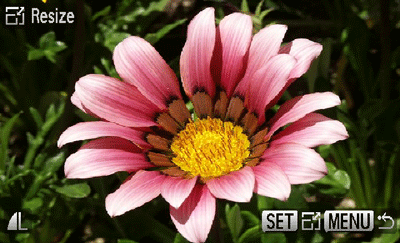

- #HOW TO RESIZE AN IMAGE IN CANON IMAGE GARDEN HOW TO#
- #HOW TO RESIZE AN IMAGE IN CANON IMAGE GARDEN FULL#
I’ve taken the print sizes from those offered by two popular commercial printers. The following table expands this analysis to a wider range of sizes, with the blue rows showing the paper sizes which are a good match for uncropped images from full-frame or APS-C DSLRs and the yellow rows showing the good matches for uncropped images from compact cameras. Not ideal again.A3 paper is twice the area of A4 but the aspect ratio is exactly the same as A4. An image from a digital compact cannot be printed without cropping or uneven margins.ĥ″ * 7″ paper has an aspect ratio of 1.4 – so it’s not an ideal shape for printing from any digital camera.Ī4 paper (the dimensions are 210mm * 297mm) has an aspect ratio of 1.41.
#HOW TO RESIZE AN IMAGE IN CANON IMAGE GARDEN FULL#
So a print from a full frame or APS-C camera will print onto the paper without any cropping. Taking the smallest size, 6″ * 4″ paper has an aspect ratio of 1:1.5 or 3:2. If you’re sending your images to a commercial printer then a wider choice is available. If you’re printing at home your likely choices are 6″ * 4″, 5″ * 7″, A4, and A3, in increasing order of size. We can compare this to the sizes of paper which are commonly available for printing digital images. So now we know the most common aspect ratios for digital sensors: The ratio is 4272/2847 = 1.5 again.ĭigital compacts usually have a ratio of 1.33 For example, the Canon EOS450D has 2848 * 4272 pixels, about 12.2 megapixels.

The physical size of the sensor is smaller than the full-frame cameras, but the ratio of the width to height is the same. “APS-C” digital SLRs – the vast majority of digital SLRs on the market today – also have this 1:1.5 ratio. For example, the Canon EOS5D Mark II has a sensor with 3744 * 5616 pixels, approximately 21 megapixels. This can also be expressed as a 3:2 ratio. The number of pixels will vary from one model to another, but the ratio of the long side to the short side will always be 1.5:1. “Full frame” digital cameras have sensors measuring 24mm * 36mm (the same size as 35mm film). But in my defence, I’d like to point out that camera designers and print manufacturers have done little to harmonise the dimensions of their sensors to match common print sizes – even though sometimes the same companies produce both products. It seems so obvious now that I’m almost embarrased to admit that it took me a while to understand. The ratio of your image width to image height must match the ratio of the paper width to height. Even this weighty tome failed to mention the important point, which is: Later, when I started using Lightroom, I purchased a very good book which devotes around 30 pages to the print module. I tried all manner of programs but they didn’t seem to work. It seems a simple question, but I have to confess that it was one that had me stumped for quite a while when I started to print digital images on a home inkjet.
#HOW TO RESIZE AN IMAGE IN CANON IMAGE GARDEN HOW TO#
In a previous article I looked at how to resize images for web display now it’s time to consider how to size photos appropriately for printing, specifically how to ensure that you can print onto a given size of paper without stretching or squashing your image, or having to accept uneven borders.


 0 kommentar(er)
0 kommentar(er)
